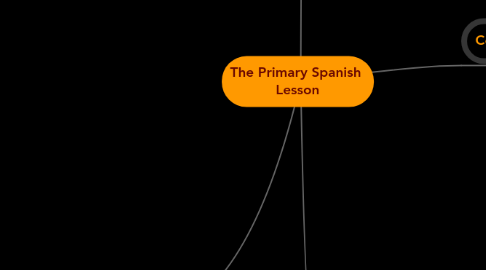
1. Presenting the Lesson
1.1. Factors to be Considered
1.1.1. An extended listening period
1.1.2. Positive reinforcement
1.1.3. Content must be meaningful
1.1.4. Content must be comprehensible
1.1.5. Low-stress learning environmentNew node
1.2. Stages of the Lesson
1.2.1. Warm-up and Recycle
1.2.1.1. Provides opportunities for review Supports transition from lesson conducted in the NL Helps learners to be confident
1.2.2. Presenting New Language
1.2.2.1. The basis for all other activities
1.2.2.2. Must be supported with vocabulary cards, flash cards, pictures, realia
1.2.2.3. Puppets should be used to model questions and responses Makes the presentations more natural and logical
1.2.3. Practice and Reinforcement Activities
1.2.3.1. Need for a variety of contexts in which to practice the new content
1.2.3.2. Need for variety The younger the class, the greater the need for variety
1.2.3.3. Encourage learners to be physically involved in the language learning
1.2.3.4. Pay attention to energy requirements
1.2.4. Wrap-up
1.2.4.1. Brief overview of what was actually accomplished
1.2.4.2. Praise learners for their interest, their listening skills and their efforts to use the language
1.2.4.3. Indicate Indicate that you are looking forward to the next lesson
1.3. Teaching Approaches
1.3.1. Total Physical Response (TPR)
1.3.1.1. A physical response to a command or direction that serves to help children to learn vocabulary and structures
1.3.1.2. Physical response helps children to retain what they are learning
1.3.1.3. Supports the need for physical activity
1.3.1.4. Supports the existence of a low affective filter
1.3.2. The Natural Approach
1.3.2.1. Supports an extended listening period
1.3.2.2. Comprehensibility Enunciate clearly, use short words and expressions, keep the message simple and easy to absorb
1.3.2.3. Meaningful Content draws on children's interests Visuals help to support comprehensibility and meaningfulness
2. Learning Environment
2.1. Non-threatening
2.1.1. Treat efforts with respect, praise and encouragement
2.1.2. Results in a positive attitude towards the new language and its related culture
3. Objectives
3.1. Listening
3.1.1. Show comprehension of basic vocabulary, structures and expressions
3.2. Speaking
3.2.1. Demonstrate comprehension of aural and visual stimuli, using words, phrases and short sentences. Non-verbal responses are also acceptable
